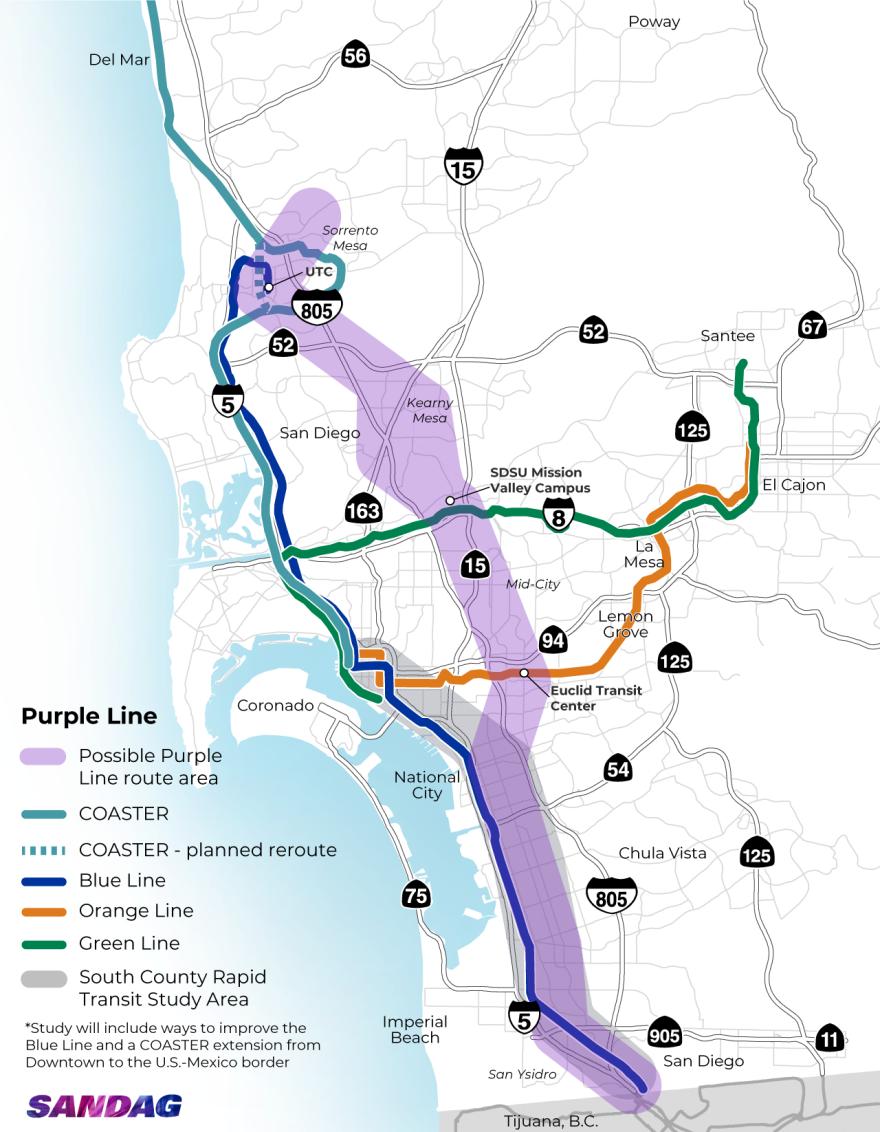San Diego County's transportation agency, the San Diego Association of Governments (SANDAG), recently completed a planning study of the Purple Line, a long-planned high-speed transit connection between San Ysidro and Sorrento Mesa.
The study analyzes how the Purple Line would work as a heavy rail line, with faster speeds and higher capacities compared to the existing trolley. The mostly underground line could provide a car-free connection between National City and Sorrento Mesa in 26 minutes — easily twice as fast driving during rush hour traffic.
The vision of connecting South Bay suburbs with job centers in northern San Diego via high-speed rail might sound appealing. But the cost estimates have caused even supporters of the Purple Line to question whether it's realistic or just a fantasy.
The Purple Line Conceptual Planning Study analyzed only a portion of the corridor and did not consider real estate or financing costs. Still, it came up with a low-end price tag of $20.7 billion.
That's roughly 10 times what San Diego spent extending the Blue Line trolley to University City. The unsuccessful sales tax measure on last year's ballot would have collected only a third of the Purple Line's construction costs after 20 years.
"There's no way that SANDAG is going to have that much money," said Colin Parent, executive director of the nonprofit Circulate San Diego. "Even if they did have that much money, they wouldn't — and certainly shouldn't — spend it just on one project."
One of the main cost drivers is San Diego's topography. The tracks would have to be deep underground when passing through the mesas of central San Diego, then navigate a steep drop going into Mission Valley.
Jesse Ramirez, urban planning director for the City Heights Community Development Corporation, said he's glad SANDAG is giving more attention to the Purple Line concept and that the study provides useful information on how to move forward. SANDAG staff say they will also analyze nearer-term transit improvements such as rapid bus services.

Ramirez added that even the status quo, which makes car ownership all but mandatory for most people, is also extremely expensive to consumers and taxpayers alike.
"Yes, the price tag is high, but it's important to think about it in that context as well, how much we spend on our infrastructure as a whole," Ramirez said. "And that includes, of course, freeways, freeway expansions and freeway maintenance."
But the engineering challenges are real and unavoidable, Ramirez acknowledged. And he said his job of engaging regular people in urban planning efforts is made difficult when the focus is on mega projects that take decades to materialize — a phenomenon he called "planning fatigue."
"You get them all excited, you engage with them, and then the engagement fizzles out because we don't know what's going to happen with the project," Ramirez said. "You start getting community members asking the question, 'Well, why even participate to begin with?'"
The Purple Line study was initiated under SANDAG's previous CEO, Hasan Ikhrata, who encouraged a sky's-the-limit approach to transportation planning. His successor, former Caltrans executive Mario Orso, has pushed the agency to scale back its ambitions and focus on its basic function of planning and building transportation infrastructure.
That's an approach that's appreciated by San Diego City Councilmember Sean Elo-Rivera, who serves on the SANDAG Transportation Committee. He said he wants more focus on improving the speed and reliability of the existing public transit network — which is already facing a structural deficit of roughly $100 million.
"An awesome concept of a transportation project does not move people," Elo-Rivera said. "That doesn't mean not dreaming big or hoping for great things for San Diego. But I do think that we need to center the goals and the needs of the community as we're charting the course forward so that we can actually deliver for folks."






